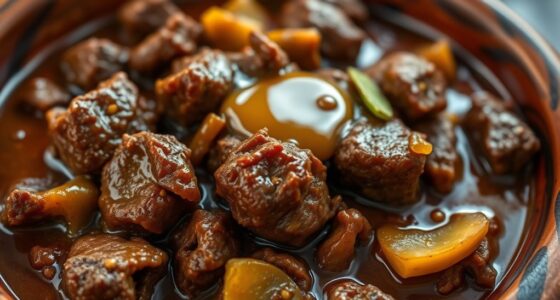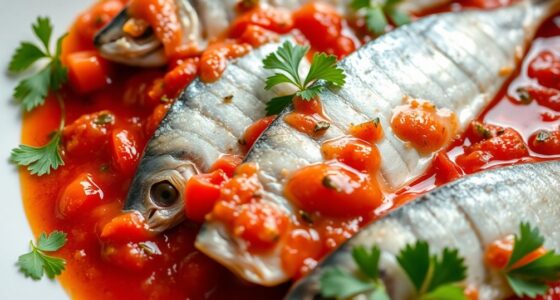As you embark on this culinary journey, think back to the first time you indulged in a plate of steaming dumplings or a savory bowl of noodle soup. The *aromas* from the kitchen, the vibrant colors on your plate, and the joy of sharing dishes with friends and family evoke a sense of warmth and community. Chinese cuisine doesn’t just nourish the body; it tells a story of tradition, culture, and familial love. Every bite offers a glimpse into the authentic flavors and rich history that span thousands of years. From sizzling stir-fries to delicate dim sum, you’ll find that Chinese food is a tapestry woven from diverse regional influences and time-honored cooking techniques. So, fasten your seatbelt as we dive into the world of traditional Chinese dishes that are not just meals but experiences waiting to be savored.
Key Takeaways
- Chinese cuisine is a rich tapestry of flavors and traditions.
- Understanding authentic Chinese food enhances your dining experience.
- Discover regional specialties and must-try dishes like Peking Duck and Kung Pao Chicken.
- Experience the communal aspect of dining through dishes like Hot Pot.
- Simple cooking techniques can bring authentic flavors to your home kitchen.
Introduction to Chinese Cuisine
Chinese cuisine stands as one of the world’s oldest culinary traditions, tracing its origins back over 2,000 years. It reflects a rich tapestry of cultural influences that have evolved throughout history. Central to these influences are the principles of harmony and balance, rooted in ancient philosophies. Your culinary journey through this vibrant cuisine will uncover a multitude of famous chinese flavors and regional chinese specialties that highlight its vast diversity.
A Brief History
The foundation of chinese culinary traditions is deeply intertwined with the development of agricultural practices along the Yellow River. As the Han culture expanded, so too did the variety of ingredients and cooking styles. Traditional meals emphasize a balance among four essential food groups: fruits, vegetables, grains, and meats, while dairy features less prominently. This focus on fresh, in-season ingredients and live seafood showcases a commitment to quality and flavor.
Regional Influences
China is home to 23 provinces, each boasting distinct culinary styles influenced by geography and climate. From the hearty wheat-based dishes of the North to the light, seafood-centric offerings of the South, each region reflects its unique lifestyle and agricultural products. Eight main culinary regions highlight this spectacular range:
- Cantonese: Known for its mild flavors and emphasis on freshness.
- Sichuan: Famous for its bold spicy dishes, thanks to the region’s humid climate, promoting the growth of hot peppers.
- Hunan: Recognized for its spicy and sour balance, using robust flavors like ginger and chilis.
- Jiangsu: Showcases umami-rich dishes with meticulous cooking techniques.
- Zhejiang: Celebrated for subtle sweetness and fresh ingredients, often with seafood.
- Anhui: Focuses on simple preparations like braising, often using wild herbs.
- Fujian: Renowned for its light and flavorful soups.
- Shandong: The oldest culinary tradition, recognized for its crispy textures and use of soy sauce.
These regional chinese specialties reveal the diversity within the cuisine, demonstrating how geography, climate, and culture converge to create an array of delicious dishes.
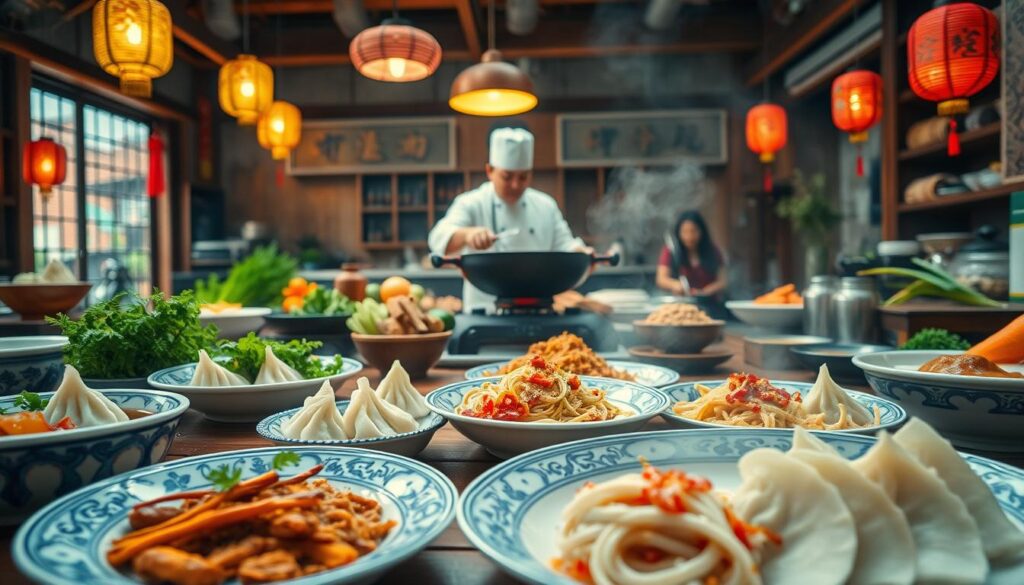
Popular Chinese Dishes You Must Try
Exploring popular Chinese recipes can open up a world of flavors and experiences. This rich cuisine showcases a variety of dishes, each reflecting its unique cultural heritage. You’ll find that these selections not only represent authentic Chinese food but also offer unforgettable dining experiences. Let’s dive into three must-try dishes that stand out for their taste and history.
Peking Duck
Peking Duck is a culinary icon from Beijing, renowned for its incredibly crispy skin and tender meat. Traditionally served with pancakes, hoisin sauce, and sliced vegetables, this dish offers a delightful combination of textures and flavors. The meticulous roasting method, employing a special oven, showcases years of tradition in preparing authentic Chinese food. Peking Duck has even been recognized as a “national dish of diplomacy,” due to its historical significance.
Kung Pao Chicken
Originating from the Sichuan province, Kung Pao Chicken features diced chicken stir-fried with crunchy peanuts, colorful vegetables, and invigorating chili peppers. This dish embodies the essence of bold flavors accentuated by a delightful nutty finish. As one of the most popular Chinese recipes, it highlights the vibrant nature of Sichuan cuisine while appealing to a wide range of palates.
Mapo Tofu
Known for its spicy profile and floral aromas, Mapo Tofu is a beloved dish in Sichuan cuisine. The harmonious blend of soft tofu, minced meat, and a unique mixture of fermented black beans delivers a complex interplay of savory, spicy, and numbing tastes. This dish not only carries over a century of culinary history but also stands as a testament to the authenticity of Chinese flavors.
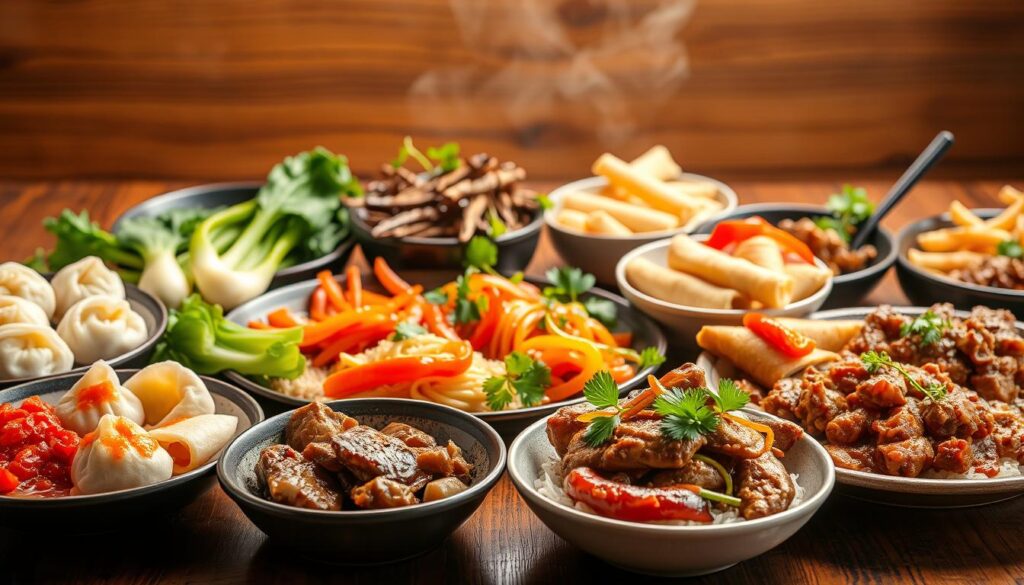
| Dish | Region | Main Ingredients | Taste Profile |
|---|---|---|---|
| Peking Duck | Beijing | Duck, hoisin sauce, pancakes | Crispy, savory, sweet |
| Kung Pao Chicken | Sichuan | Chicken, peanuts, vegetables, chili | Spicy, nutty, bold |
| Mapo Tofu | Sichuan | Tofu, ground meat, fermented black beans | Spicy, savory, complex |
These dishes represent just a glimpse into the rich tapestry of popular Chinese recipes that you can savor. Whether you indulge in the crispy skin of Peking Duck or the bold flavors of Kung Pao Chicken, you’re sure to enjoy the authentic experience that Chinese cuisine has to offer.
Essential Ingredients in Chinese Cooking
Understanding the essential ingredients in Chinese cooking opens up a world of flavors and techniques. These staples form the foundation of many dishes and are integral to mastering various chinese cooking techniques. Here are the key ingredients you should know:
Rice and Noodles
Rice is the predominant staple in southern China, while northern regions favor noodles made from wheat. You will discover numerous styles of noodles, including hand-pulled varieties. These essentials form the base of various meals, contributing both texture and substance.
Soy Sauce and Other Sauces
Soy sauce is crucial for enhancing the flavor of dishes, with two main types: light and dark. Light soy sauce is thinner and saltier, while dark soy sauce adds a richer taste. Other important sauces include oyster sauce, which is valuable for elevating the flavors of dishes and is worth the investment for its unique essence.
Fresh Herbs and Spices
The combination of ginger, garlic, and scallions serves as the holy trinity of Chinese cooking. Each ingredient adds depth and complexity, elevating your meals. Fresh herbs and spices, including white pepper and Sichuan peppercorns, introduce aromatic layers that are often found in the offerings of the best chinese restaurants.
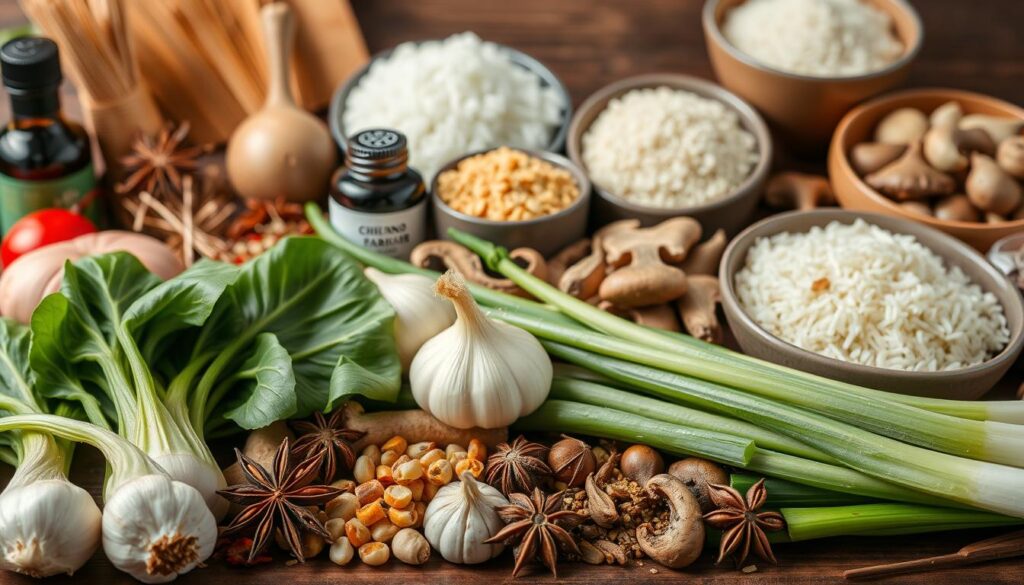
Regional Varieties of Chinese Cuisine
Exploring the regional varieties of Chinese cuisine reveals a fascinating tapestry of flavors and cooking styles. Each region boasts distinct characteristics, contributing to the rich culinary heritage of the country. The interplay of geography, climate, and history shapes the ingredients and techniques employed in these regional specialties.
Cantonese Cuisine
Cantonese cuisine highlights fresh ingredients and mild flavors. Famous for dishes like dim sum and char siu (barbecue pork), this regional specialty emphasizes a balanced palette through techniques like steaming and wok frying. Common seasoning agents include garlic and various sauces, which enhance the natural taste of the ingredients.
Sichuan Cuisine
Sichuan cuisine stands out due to its bold and spicy profile. A proud showcase of famous Chinese flavors, it utilizes potent peppers, garlic, and aromatic spices that thrive in the humid climate of the region. Dishes such as Mapo Tofu and Kung Pao Chicken exemplify the intensity and depth of flavor characteristic of this cuisine, making it popular worldwide.
Hunan Cuisine
Known for its fiery heat, Hunan cuisine offers a mix of spicy and sour flavors. Ingredients like chili peppers take center stage, along with fresh vegetables and smoked meats. Dishes such as Dong’an Chicken not only emphasize heat but also highlight the overall freshness of the components used. Compared to Sichuan, Hunan dishes tend to be less oily, emphasizing a clean and invigorating taste.
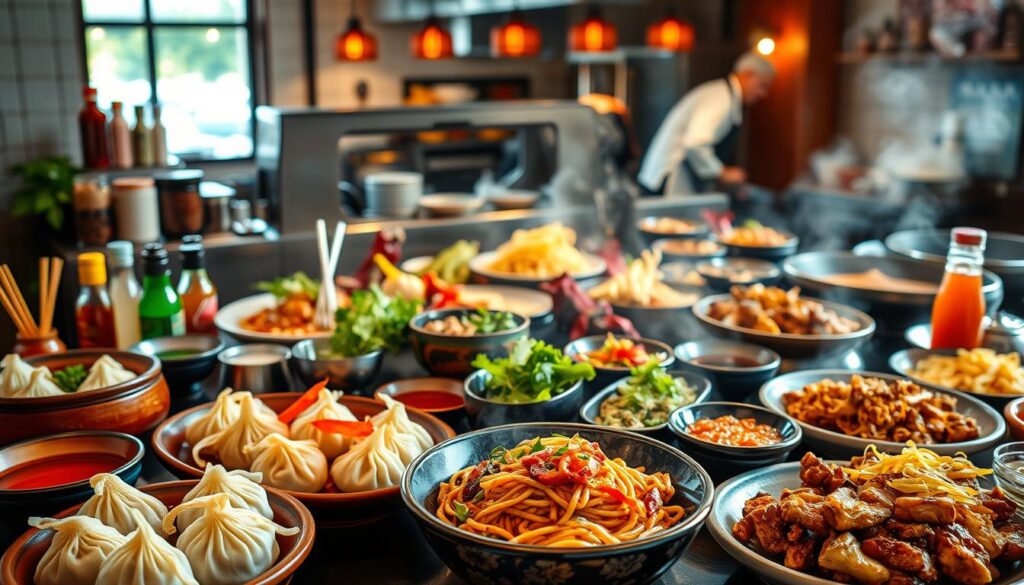
| Region | Key Features | Notable Dishes |
|---|---|---|
| Cantonese | Mild flavors, fresh ingredients | Dim Sum, Char Siu |
| Sichuan | Bold and spicy, potent peppers | Mapo Tofu, Kung Pao Chicken |
| Hunan | Fiery spice, fresh and sour | Dong’an Chicken, Spicy Noodles |
Cooking Techniques in Chinese Cuisine
Chinese cooking techniques play a vital role in preparing traditional Chinese dishes, highlighting a range of methods designed to accentuate flavors and textures. The skillful use of these techniques often determines the success of the final dish. Understanding these methods can enhance your experience in Chinese cooking, whether you are preparing a family meal or trying out a new recipe.
Stir-Frying
Stir-frying stands out as one of the most celebrated chinese cooking techniques. This high-heat method involves quickly cooking ingredients in a small amount of oil while constantly stirring. It captures the freshness of vegetables and enhances the flavors, making it ideal for popular dishes like fried rice and chow mein. To achieve the perfect stir-fry, preheat the wok until almost smoking, ensuring the ingredients sear effectively.
Steaming
Steaming is another essential technique in Chinese cuisine, recognized for its health benefits. This method involves cooking food over boiling water, allowing steam to gently cook the ingredients. It is often used for preparing dim sum and fish dishes, as steaming preserves most nutrients. Unlike boiling, which can leach flavors and vitamins, steaming retains the food’s essence, aligning with traditional dietary principles.
Braising
Braising combines both moisture and heat, allowing for deep flavor development in traditional Chinese dishes. This method involves cooking ingredients slowly in a small amount of liquid, fostering richness and tenderness. Dishes like red-braised pork exemplify this technique, showcasing how braising can enhance the meal’s overall taste and texture through careful attention over time.
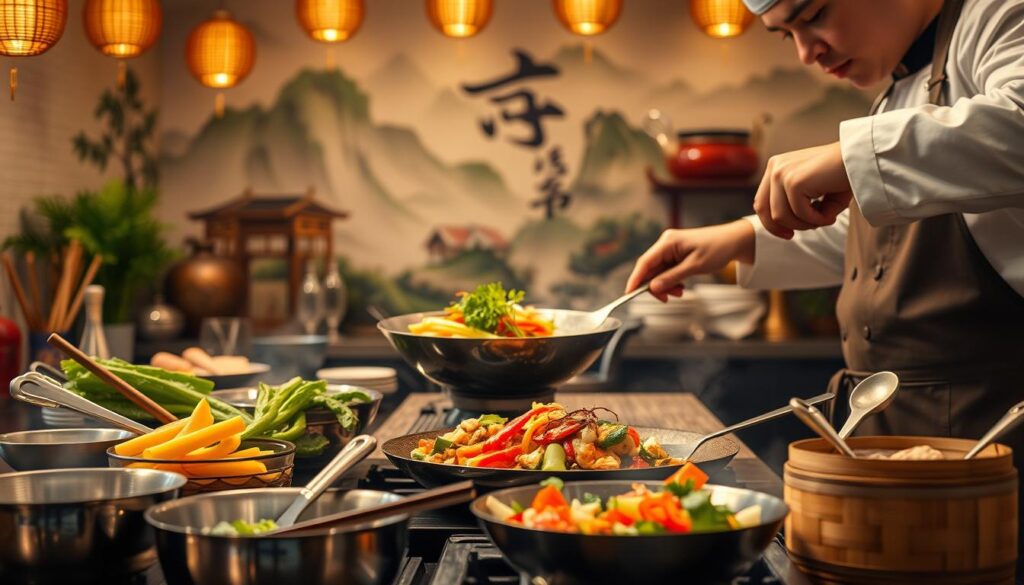
Dim Sum: A Unique Dining Experience
Dim sum represents a vibrant aspect of the Chinese dining experience. This traditional Cantonese meal, often enjoyed during brunch, features an array of small plates served alongside tea. Guests are encouraged to share and sample a variety of dishes, making it a social and flavorful gathering. When looking for the best Chinese restaurants, you’ll find those that specialize in dim sum stand out for their charming atmospheres and diverse menus.
What is Dim Sum?
Dim sum revolves around the idea of small, bite-sized dishes, and it pairs beautifully with tea. This culinary concept encourages diners to explore a range of flavors, from sweet to savory. It has become a popular choice in many American cities, particularly in Los Angeles, where a plethora of options can be found.
Popular Dim Sum Dishes
- Siu Mai – These pork dumplings are a must-try, delighting with their taste and texture.
- Har Gow – Shrimp dumplings known for their delicate wrappers and fresh flavors.
- Egg Tarts – Often served as a sweet finale, these tarts provide a scrumptious finish to a dim sum meal.

Tips for Enjoying Dim Sum
When you dine at one of the best Chinese restaurants for dim sum, consider ordering a variety of dishes to share among your group. This way, you can savor multiple flavors and discover new favorites. Pair your meal with tea to enhance your experience further. In areas like the San Gabriel Valley, known for its exceptional dim sum offerings, you may find yourself waiting hours during peak times at popular spots like Happy Together. Alternatively, Ocean Bo provides many dim sum items at affordable prices, attracting budget-conscious food lovers.
The Role of Tea in Chinese Culture
Tea holds a significant place in the tapestry of Chinese culinary traditions, symbolizing hospitality and cultural depth. As you delve into the various types and practices surrounding tea, you will find how it intertwines with the overall chinese dining experience and enhances various meals.
Types of Chinese Tea
Chinese tea comes in a rich variety of types, each with unique characteristics. Here’s a brief overview:
| Type of Tea | Description | Brewing Temperature |
|---|---|---|
| Green Tea | Light and fresh, often containing higher antioxidant levels. | 160-180°F (70-80°C) |
| Black Tea | Strong and robust flavor, fully oxidized leaves. | 200-212°F (93-100°C) |
| Oolong Tea | Partially oxidized, offers a balance between green and black tea. | 190-205°F (88-96°C) |
| Pu-erh Tea | Fermented, with earthy flavors that improve with age. | 200-212°F (93-100°C) |
Tea Pairing with Food
Pairing tea with food can elevate your chinese dining experience significantly. Certain teas complement specific dishes beautifully. For example:
- Oolong tea pairs well with dim sum, enhancing the flavors of dumplings.
- Jasmine tea goes nicely with lighter fare, accentuating delicate tastes.
- Black tea complements richer dishes, providing a balancing contrast.
Health Benefits of Tea
Beyond being a staple in daily routines, tea is celebrated for its numerous health benefits:
- Promotes digestion, especially after meals.
- Offers relaxation, making it an ideal beverage for winding down.
- Packed with antioxidants, contributing to overall health.
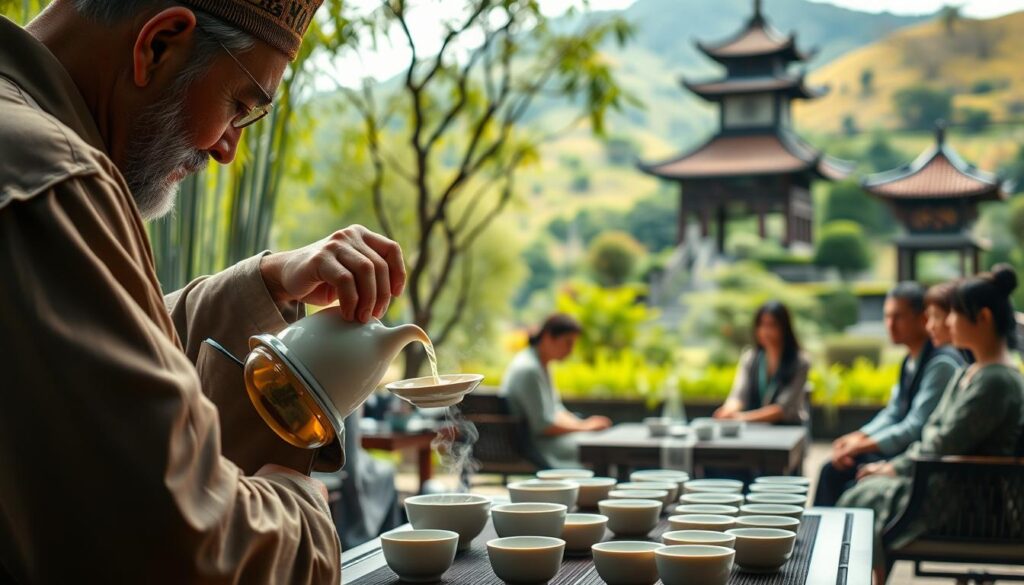
Vegetarian Options in Chinese Cuisine
Exploring vegetarian options in Chinese cuisine reveals a vibrant array of dishes that highlight the use of fresh ingredients and bold flavors. With about 30% of the population in China adhering to vegetarian lifestyles influenced by Taoism and Buddhism, the variety of authentic Chinese food reflects a long-standing tradition of plant-based eating. You will find numerous popular Chinese recipes showcasing tofu, vegetables, and grains suited for those who prefer to dine without meat.
Tofu Dishes
Tofu is truly a standout in vegetarian Chinese cooking. This versatile protein is featured in many dishes, including Mapo tofu, which can easily be customized to be meat-free by omitting ground pork. You can enjoy crispy tofu stir-fried with vegetables in Kung Pao tofu, creating a satisfying meal packed with flavors. Tofu provides the perfect foundation for many authentic Chinese food recipes that cater to vegetarian palates.
Vegetable Stir-Fries
Vegetable stir-fries offer a quick and nutritious meal option. These dishes often include a variety of colorful vegetables such as mushrooms, cabbage, and carrots, cooked with aromatic spices. Many restaurants serve vegetable dumplings accompanied by sweet and sour sauce, which is typically free of animal products. With seasonal produce, these stir-fries not only capture the essence of healthy eating but are also a delicious representation of popular Chinese recipes.
Noodle and Rice Options
When it comes to noodles and rice, the vegetarian alternatives are abundant. Fried rice can be prepared with vegetables and tofu, ensuring robust flavors while accommodating various dietary preferences. Noodle dishes like vegetable lo mein and chow mein are great choices when seeking a hearty meal. Each of these options allows you to enjoy authentic Chinese food while exploring the rich variety of vegetarian ingredients.
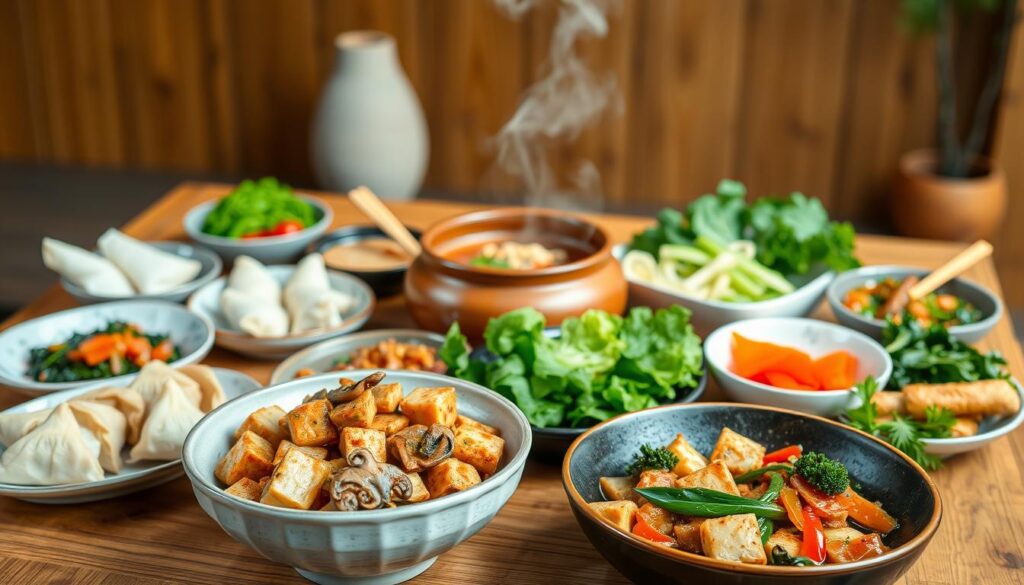
Chinese Desserts to Satisfy Your Sweet Tooth
Exploring the world of Chinese desserts reveals a delightful array of flavors and textures. From traditional staples to modern adaptations, these authentic Chinese food options will surely satisfy your sweet cravings. Each dessert carries its own cultural significance, making every bite a taste of history and tradition.
Mooncakes
Mooncakes stand out as a celebrated dessert, particularly during the Mid-Autumn Festival. These pastries feature a rich filling, often prepared with lotus seed paste, wrapped in a thin crust. Their beautifully intricate designs symbolize family togetherness and harmony. A nod to traditional Chinese dishes, mooncakes are an essential part of celebrations.
Mango Pudding
This refreshing dessert offers a contemporary twist, made from ripe mangoes, milk, and sugar. Served cold, mango pudding has become a modern favorite in many Chinese restaurants. Its appealing taste and vibrant color evoke pleasure, showcasing how traditional Chinese dishes can evolve while retaining their authenticity.
Sesame Balls
Known for their delightful contrast, sesame balls are deep-fried and filled with sweet red bean paste. Coated in sesame seeds, these treats reflect a blend of textures and flavors. As part of traditional Chinese desserts, sesame balls highlight the creativity and innovation inherent in authentic Chinese food.
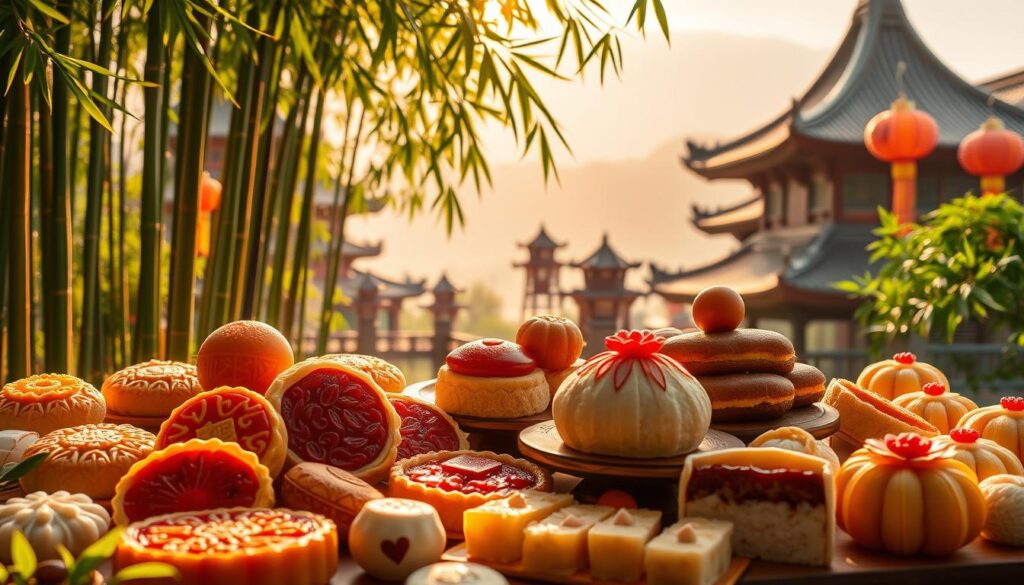
Embracing Chinese Food at Home
Cooking authentic Chinese food at home becomes an exciting journey when you have the right tools and ingredients. Whether you are a novice or an experienced cook, embracing popular Chinese recipes can turn your kitchen into a culinary playground. Understanding the essential utensils, exploring simple recipes, and knowing where to buy ingredients will enable you to create delicious meals that celebrate Chinese culture.
Essential Utensils and Cookware
To replicate authentic flavors, equip your kitchen with some essential utensils and cookware. A good-quality wok is crucial for stir-frying and creating that perfect sear. A bamboo steamer allows for gentle cooking of dumplings and vegetables, while a sturdy spatula aids in flipping and mixing ingredients. Don’t forget chopsticks, which add to the experience of enjoying authentic Chinese food at home.
Simple Recipes to Start With
If you are new to cooking, start with simple recipes that yield satisfying results. Fried rice is a classic dish that allows you to use leftover rice and random vegetables. Stir-fried vegetables provide a quick and healthy option, showcasing the freshness of your ingredients. Egg fried noodles are another easy-to-follow recipe that embraces the comforting flavors of popular Chinese recipes.
Where to Buy Ingredients
Finding the right ingredients is key to preparing authentic Chinese food. Local Asian markets often carry a wide range of fresh produce, spices, and sauces that are essential for your dishes. Items like soy sauce, rice vinegar, and five-spice powder should be readily available. Shopping at these markets not only supports local businesses but also helps you discover ingredients that elevate your cooking.
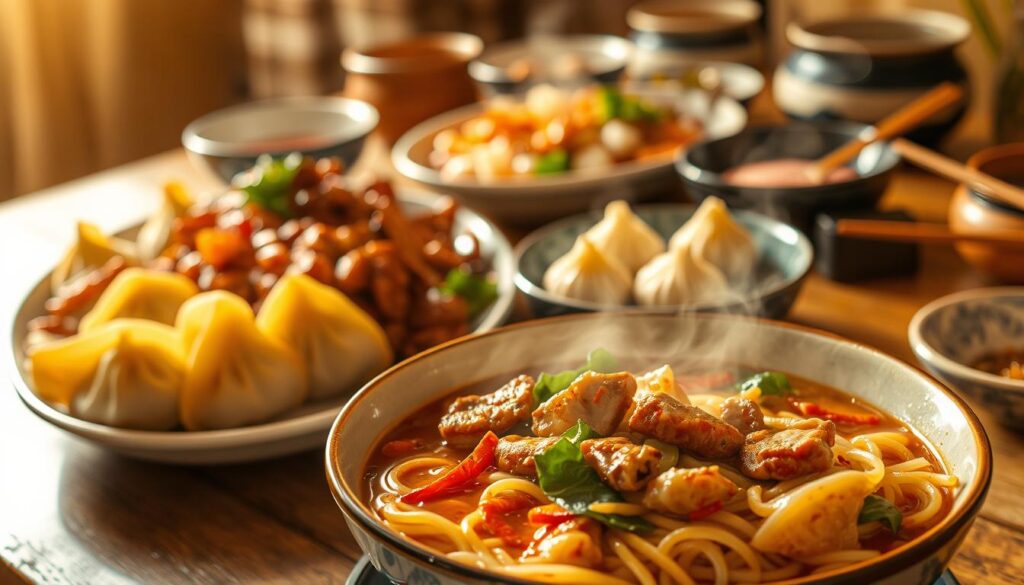
Chinese Street Food Favorites
Street food in China represents a vibrant and essential part of its culinary culture, showcasing the diversity of regional chinese specialties. From savory buns to crispy snacks, these foods reflect both tradition and innovation. You can find these delightful treats at bustling markets and street corners, making them a favorite among locals and tourists alike. Explore some of the most beloved street food options that truly encapsulate the heart of Chinese gastronomy.
Baozi and Jiaozi
Baozi, commonly referred to as big buns, are ideal for breakfast or any meal. These steamed delights can be filled with a variety of meats or vegetables, making them versatile options. On the other hand, jiaozi, shaped like ancient gold ingots, hold significance during Chinese New Year, symbolizing wealth and good fortune. Together, they embody the essence of regional chinese specialties found throughout the streets.
Stinky Tofu
Stinky tofu is a dish that many find either appealing or off-putting due to its strong aroma. Often deep-fried to achieve a crispy exterior, it reveals a soft and flavorful core. Typically served with a spicy dipping sauce, this unique treat illustrates the bold flavors present in street cuisine, making it a staple in the best chinese restaurants that aim to offer authentic experiences.
Scallion Pancakes
Cong you bing, or scallion pancakes, are a popular snack offering a delightful flaky texture combined with savory scallions. These pancakes make a great addition to any meal or can be enjoyed on their own. Their popularity highlights the widespread appreciation for simple yet flavorful snacks found in both homes and the best chinese restaurants.
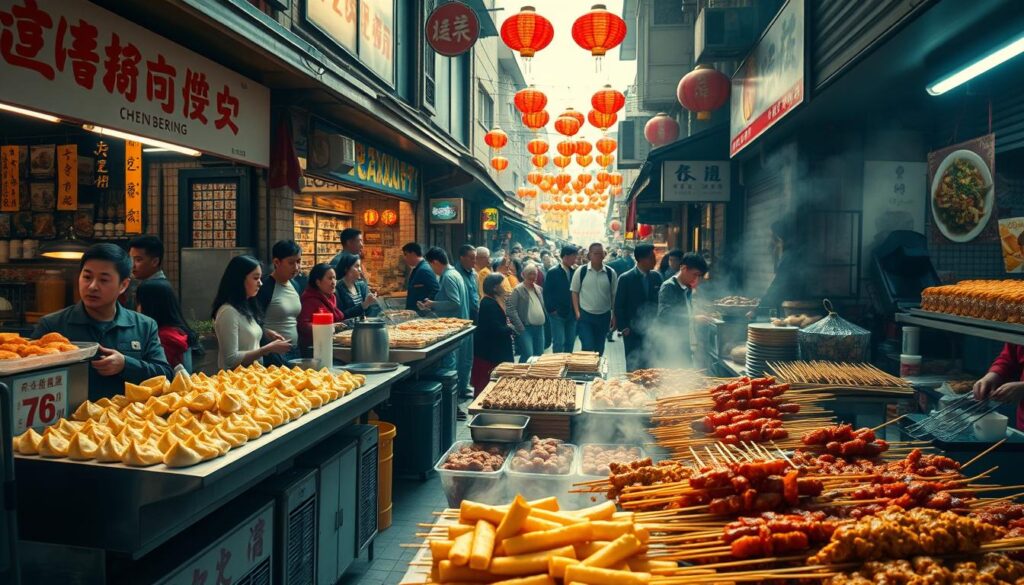
Understanding Chinese Food Customs
Delving into the nuances of a chinese dining experience reveals the rich tapestry of customs that define it. Dining etiquette, family-style meals, and celebratory dishes all play pivotal roles in elevating authentic chinese food beyond mere sustenance to a cultural ritual.
Eating Etiquette
Chinese dining customs emphasize politeness and respect, creating a harmonious atmosphere during meals. It is customary to take food quickly from communal dishes, leaving a small amount on your plate as a sign of satisfaction. Avoid sticking chopsticks upright in your rice bowl, as this mimics incense used in funeral rites, and instead, rest them on the chopstick holder provided.
Family-Style Dining
During meals, multiple dishes typically fill the center of the table, reflecting the tradition of communal eating. This setup encourages sharing and allows everyone to sample a diverse array of foods. Each diner usually has their own rice bowl, while the main dishes are served on communal plates. This approach to dining fosters a sense of abundance and unity among diners, emblematic of the authentic chinese food experience.
Celebratory Dishes
Special occasions often call for specific dishes that carry rich symbolism. For instance, longevity noodles represent long life during birthday celebrations, while fish is a symbol of prosperity, frequently served during wedding banquets. Chinese culture deeply intertwines food with meaningful customs, making each meal a celebration of life.
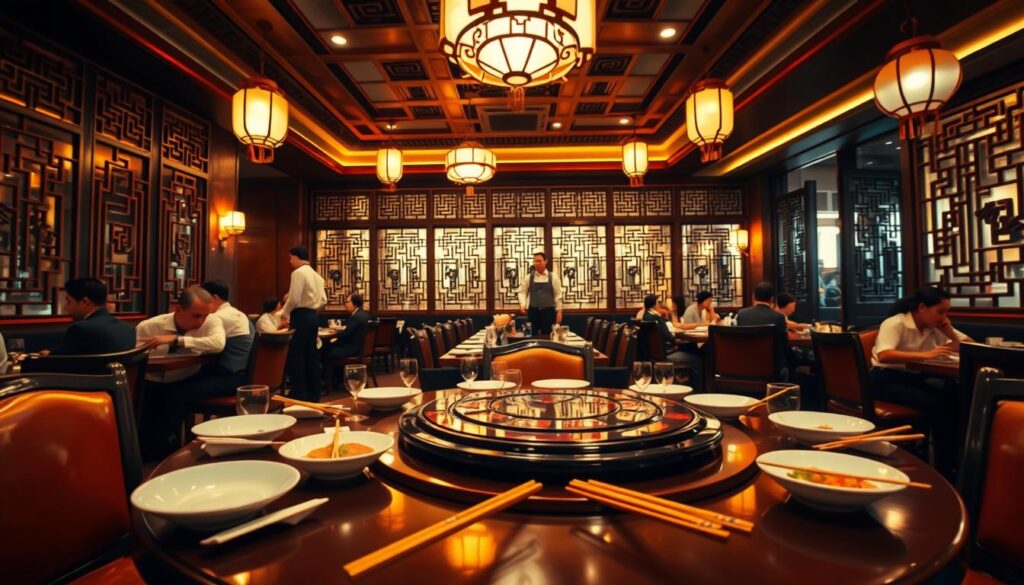
| Celebration | Significant Dish | Symbolism |
|---|---|---|
| Birthday | Longevity Noodles | Long life |
| Wedding | Fish | Prosperity |
| Graduation | Buddha’s Delight | Good luck |
China’s Influence on Global Cuisine
Chinese culinary traditions have greatly influenced global dining, introducing an array of famous Chinese flavors to food enthusiasts across the world. The blend of ancient techniques with modern innovations has paved the way for a vibrant fusion of tastes. As you explore this culinary phenomenon, you will discover how Chinese cuisine has evolved and integrated into various cultural contexts.
Fusion Foods
The incorporation of Chinese elements into local cuisines has resulted in exciting fusion foods. Creative chefs experiment with classic recipes and ingredients to craft unique dishes that resonate with diverse palates. This movement not only preserves traditional flavors but also adapts them to contemporary tastes, offering diners fresh and engaging experiences. The neo-Chinese cuisine trend emphasizes a balance between East and West, showcasing innovative approaches that reflect the evolving culinary landscape.
Chinese Restaurants Worldwide
Chinese restaurants have become ubiquitous in major cities worldwide, serving as a gateway to these rich culinary traditions. Many establishments honor the authenticity of traditional recipes while others embrace a modern aesthetic, like JIA, a Michelin Plate-awarded restaurant known for its exquisite offerings. As you seek out these global hotspots, you will come across a vibrant tapestry of regional specialties that capture the essence of the vast Chinese culinary landscape.
Popularization of Sichuan and Cantonese
Sichuan and Cantonese cuisines have particularly gained traction on international menus. The bold, spicy flavors of Sichuan dishes attract adventurous eaters, while Cantonese cuisine, known for its dim sum, invites enthusiasts to savor small plates of variety. As you delve into these culinary styles, you will find that their popularity reflects a growing interest in regional ingredients and cooking techniques, expanding the global appreciation of authentic Chinese dining experiences.
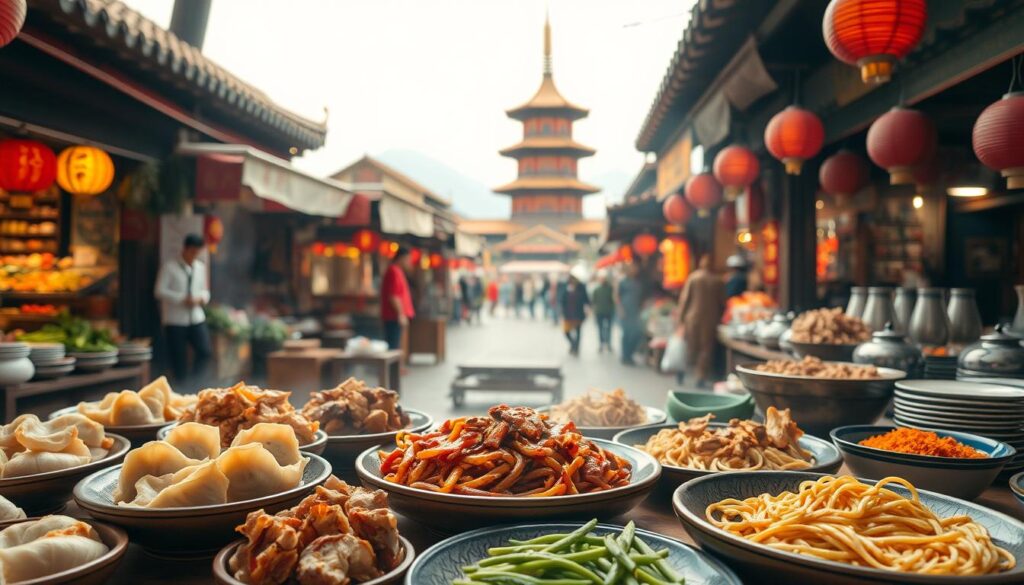
| Aspect | Fusion Foods | Chinese Restaurants Worldwide | Sichuan and Cantonese Popularization |
|---|---|---|---|
| Definition | Combining traditional Chinese and local ingredients | Global establishments showcasing diverse regional cuisines | Highly regarded Chinese regional flavors gaining popularity |
| Example | Neo-Chinese cuisine | JIA restaurant recognized for its excellence | Sichuan spicy dishes and Cantonese dim sum |
| Trend | Innovative culinary experiences | Increased demand for authentic dining | Elevated interest in regional cooking |
Conclusion: Your Journey into Chinese Cuisine
Embarking on your exploration of authentic Chinese food means diving into a world rich in flavors, history, and creativity. Whether you’re savoring a comforting bowl of congee, indulging in sumptuous Dim Sum, or mastering popular Chinese recipes in your kitchen, there’s always something new to discover. Consider visiting local Chinese restaurants or enrolling in a cooking class to deepen your appreciation. Enjoying the vibrant culinary culture of China starts with your willingness to experiment and try new dishes.
Next Steps to Explore
Your journey does not have to end here. Seek out popular dishes in your area, and don’t hesitate to ask for recommendations from staff at restaurants. If you enjoy cooking, challenge yourself by recreating your favorite meals at home. The availability of diverse ingredients has made it easier than ever to prepare authentic Chinese food in your kitchen. With every bite, you gain insights into the unique regional characteristics and the history behind each dish.
Share Your Experiences
Sharing your experiences with Chinese cuisine not only enriches your journey but also inspires others. Whether you’ve dined at a bustling street food market, tried your hand at a challenging recipe, or discovered a hidden gem of a restaurant, your stories contribute to the appreciation of this fascinating culinary tradition. Let your friends and family know about the memorable dishes you’ve tried or the delightful meals you’ve created, and encourage them to join you on this flavorful adventure!


